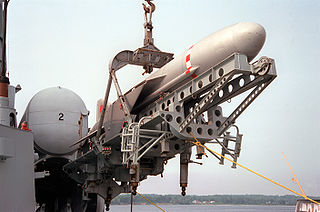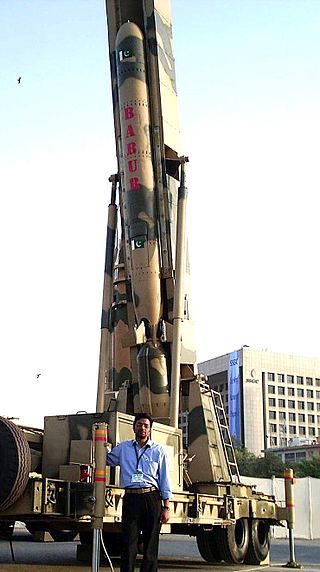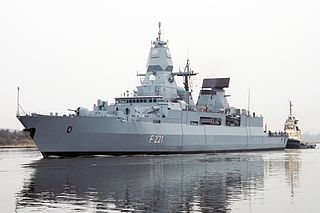Related Research Articles

The AGM-88 HARM is a tactical, air-to-surface anti-radiation missile designed to home in on electronic transmissions coming from surface-to-air radar systems. It was originally developed by Texas Instruments as a replacement for the AGM-45 Shrike and AGM-78 Standard ARM system. Production was later taken over by Raytheon Corporation when it purchased the defense production business of Texas Instruments.

A cruise missile is a guided missile used against terrestrial or naval targets, that remains in the atmosphere and flies the major portion of its flight path at an approximately constant speed. Cruise missiles are designed to deliver a large warhead over long distances with high precision. Modern cruise missiles are capable of traveling at high subsonic, supersonic, or hypersonic speeds, are self-navigating, and are able to fly on a non-ballistic, extremely low-altitude trajectory.

The P-15 Termit is an anti-ship missile developed by the Soviet Union's Raduga design bureau in the 1950s. Its GRAU designation was 4K40, its NATO reporting name was Styx or SS-N-2. China acquired the design in 1958 and created at least four versions: the CSS-N-1 Scrubbrush and CSS-N-2 versions were developed for ship-launched operation, while the CSS-C-2 Silkworm and CSS-C-3 Seersucker were used for coastal defence. Other names for this basic type of missile include: HY-1, SY-1, and FL-1 Flying Dragon, North Korean local produced KN-1 or KN-01, derived from both Silkworm variants and Russian & USSR P-15, Rubezh, P-20 P-22.

Active radar homing (ARH) is a missile guidance method in which a missile contains a radar transceiver and the electronics necessary for it to find and track its target autonomously. The NATO brevity code for an air-to-air active radar homing missile launch is fox three.

The Crotale is a French, all-weather, short-range surface-to-air missile system developed to intercept airborne ranged weapons and aircraft, from cruise or anti-ship missiles to helicopters, UAVs or low-flying high-performance fighter aircraft. It was developed by Thomson CSF Matra and consists of a mobile land-based variant as well as various naval ones.

The Babur, is an all-weather, subsonic cruise missile developed and designed by the National Defence Complex (NDC) of Pakistan.

The F124 Sachsen class is the German Navy's latest class of air-defense frigates. The design of the Sachsen-class frigate is based on that of the F123 Brandenburg class but with enhanced stealth features designed to deceive an opponent's radar and acoustic sensors. The class incorporates an advanced multifunction radar APAR and a SMART-L long-range radar which is purported to be capable of detecting stealth aircraft and stealth missiles.

The Zvezda Kh-35 is a Soviet turbojet subsonic cruise anti-ship missile. The missile can be launched from helicopters, surface ships and coastal defence batteries with the help of a rocket booster, in which case it is known as Uran or Bal. It is designed to attack vessels up to 5,000 tonnes.

The Korean People's Army Air Force is the unified military aviation force of North Korea. It is the second largest branch of the Korean People's Army comprising an estimated 110,000 members. As of 2024, it is estimated to possess some 570 combat aircraft, 200 helicopters, and a few transporters, mostly of decades-old Soviet and Chinese origin. Its primary task is to defend North Korean airspace. In April 2022, the Korean People's Army Air and Anti-Air Force name was changed to Korean People's Army Air Force.

The RIM-174 Standard Extended Range Active Missile (ERAM), or Standard Missile 6 (SM-6), is a missile in current production for the United States Navy. It was designed for extended-range anti-air warfare (ER-AAW) purposes, providing capability against fixed and rotary-wing aircraft, unmanned aerial vehicles, anti-ship cruise missiles in flight, both over sea and land, and terminal ballistic missile defense. It can also be used as a high-speed anti-ship missile. The missile uses the airframe of the earlier SM-2ER Block IV (RIM-156A) missile, adding the active radar homing seeker from the AIM-120C AMRAAM in place of the semi-active seeker of the previous design. This will improve the capability of the Standard missile against highly agile targets and targets beyond the effective range of the launching vessels' target illumination radars. Initial operating capability was planned for 2013 and was achieved on 27 November 2013. The SM-6 is not meant to replace the SM-2 series of missiles but will serve alongside and provide extended range and increased firepower. It was approved for export in January 2017.

The SSM-700K C-Star (Haeseong) is a ship-launched sea-skimming surface-to-surface anti-ship cruise missile developed by the South Korean Agency for Defense Development (ADD), LIG Nex1 and the Republic of Korea Navy in 2003. The missiles are deployed on KDX-II and KDX-III destroyers as of 2006, each carrying 8 and 16 of the missiles respectively, and on Ulsan-class frigates.

The AGM-158C LRASM is a stealth air launch anti-ship cruise missile developed for the United States Air Force and United States Navy by the Defense Advanced Research Projects Agency (DARPA). Derived from the AGM-158B JASSM-ER, the LRASM was intended to pioneer more sophisticated autonomous targeting capabilities than the U.S. Navy's current Harpoon anti-ship missile, which has been in service since 1977.

The K-300PBastion-P is a Russian mobile coastal defence missile system. The system was developed together with the Belarusian company Tekhnosoyuzproekt.

The Korean People's Army Navy (KPANF; Korean: 조선인민군 해군; Hanja: 朝鮮人民軍 海軍; MR: Chosŏn-inmingun Haegun; lit. Korean People's Military Navy; or the Korean People's Navy, is the naval component of the Korean People's Army, the North Korean armed forces.
This is a comparison list of intercontinental ballistic missiles developed by various countries.
The Pukguksong-1 or Pukkŭksŏng-1, Bukgeukseong-1, alternatively KN-11 in intelligence communities outside North Korea, is a North Korean, two-stage submarine-launched ballistic missile (SLBM) that was successfully flight tested on 24 August 2016.
The KN-09 (K-SS-X-9) is a North Korean 300 mm rocket artillery system of a launcher unit comprising eight rockets packaged in two four-rocket pods.

The Hwasong-12 is a mobile intermediate-range ballistic missile developed by North Korea. The Hwasong-12 was first revealed to the international community in a military parade on 14 April 2017 celebrating the Day of the Sun which is the birthday anniversary of North Korea's founding President, Kim Il Sung. North Korea tested Hwasong-12 on 30 January 2022.
The Hwasong-17 is a North Korean two-stage ICBM, first unveiled on 10 October 2020, the 75th anniversary of the founding of the Workers' Party of Korea (WPK) parade. The Japanese Ministry of Defence estimates its operational range at 15,000 km or more. Unlike its predecessors, the Hwasong-17 may be capable of carrying multiple warheads. North Korea claimed the first Hwasong-17 was successfully launched on 24 March 2022. Western analysts instead believe the 24 March launch was an earlier missile design, and a later test that took place on 18 November 2022 was the first successful test launch.
References
- ↑ "Kumsong-3 (KN-19)". Missile Threat. Retrieved 2022-11-20.
- ↑ "Kumsong-3 – Missile Defense Advocacy Alliance" . Retrieved 2022-11-20.
- ↑ Panda, Ankit. "North Korea's New KN19 Coastal Defense Cruise Missile: More Than Meets the Eye". thediplomat.com. Retrieved 2022-11-20.
- ↑ Panda, Ankit (2020). Kim Jong Un and the bomb : survival and deterrence in North Korea. New York, NY. p. 318. ISBN 978-0-19-006036-7. OCLC 1121083967.
KN19-The coastal defense variant of the Kumsong-3/KNO1 featuring an indigenously designed integrated transporter-erector-launcher with all-terrain treads. The missiles feature a new multi-modal seeker and considerably improved maneuverability and guidance.
{{cite book}}: CS1 maint: location missing publisher (link) - ↑ Bowers, Ian (2019). The modernisation of the Republic of Korea Navy : seapower, strategy and politics. Cham, Switzerland. pp. 34–35. ISBN 978-3-319-92291-1. OCLC 1048428673.
The KPN have also produced a coastal version of this weapon, the KNI9, which has several upgrades including the ability to perform multiple waypoint manoeuvres and more advanced terminal guidance sensors. The KPN is deploying the Kumsong-3 on its new vessels, and if they successfully integrate them they would represent a substantial step-up in capability. However, the KPN's weaknesses in sensors and networked capabilities will undermine the potential of these new systems. Without over the horizon radar, satellite systems or effective radar on networked aviation assets the KPN will struggle to find targets at the higher-end of the Kumsong-3's range.
{{cite book}}: CS1 maint: location missing publisher (link)